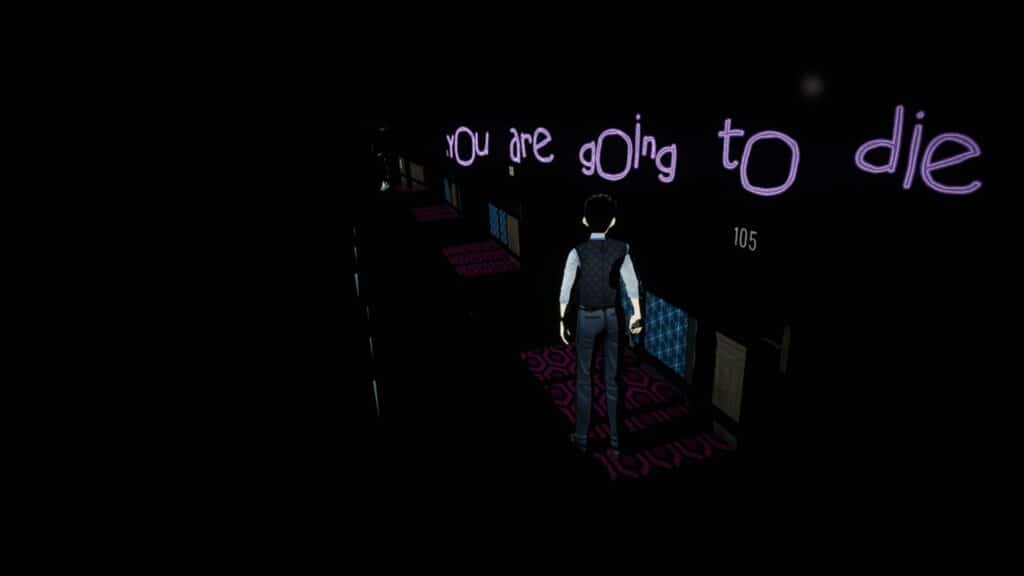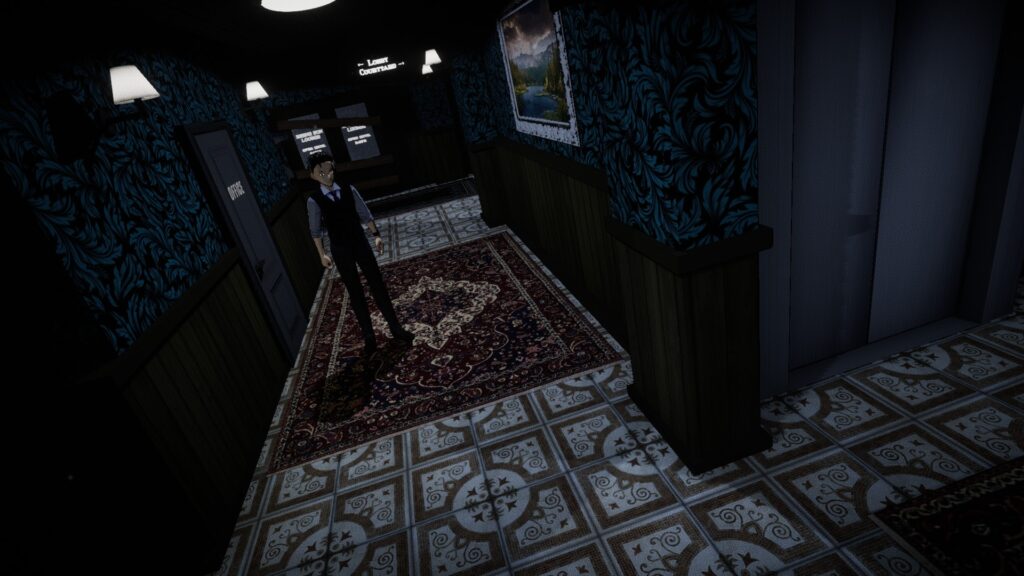Ghost at Dawn is a new survival horror game from Blue and Red Games. One look and it’s clear that it strives to emulate the survival horror classics, with fixed camera angles, limited inventory space, and a giant, spooky old building to explore.
You play Ben O’hara, a Japanese-American detective suffering from the trauma endured while serving during World War II.

Now, he’s taken a case to investigate the disappearance of Emi Kosuke, a girl who went missing in the now-defunct Pines Hotel. It’s a strong premise, and a noir thriller is perfectly suited to the old-school survival horror genre.
Blue and Red Games did well sticking to the noir themes. The hotel itself is perfectly dark and moody. Shadows cast hard, pitch black lines, art deco statues crowd the hallways, and moonlight falls through dusty windows. The vibe of the Pines Hotel is on-point, and the Dev did their homework to create a believable environment.
Most rooms are accompanied by some sleepy jazz background music that feels like something Angelo Badalamenti would have dreamed up in a dark, smokey speakeasy. Good stuff that definitely adds to the atmosphere and identity.
In old school survival homages, the environment needs to have personality, and the Pines Hotel certainly does. The grounded, nostalgic look of the hotel feels somewhat at odds with the anime-styled character models, but it never became too distracting. They’re effectively expressive and animated well enough that they grew on me by the end of the game.
Ghost at Dawn absolutely nails the fixed camera angles

There is a distinct art with the implementation of fixed camera angles. It’s much more subtle than simply throwing the camera in the corner of the room and calling it good. The camera must convey information to the player through the environment. This could be feeding you info about items located in the room, the direction you should be going, or points of interest off to the side that will then transition to a different camera angle.
It needs to withhold information as well. Maybe it’s hiding the precise location of the enemy off-screen, or it can be used to create tension via your limited field of view. Or it could simply be a cinematic shot that evokes the tone the game is going for.
Ghost at Dawn understands this. The camera angles are composed very well here. They never feel cumbersome to navigate or directly unfair to the player through enemy placement. Some tracking shots mix things up, and perfectly timed transitions are always smooth and easy to keep moving through. Really good stuff here.
Pinning it all together is the ever-important lock-on that snaps to enemies when aiming, so you have peace of mind when firing at an enemy off-screen, sure that your precious ammo won’t go to waste.
Speaking of ammo, managing resources is a key mechanic in Ghost at Dawn

In terms of gameplay, this is classic horror all the way. You slowly pick your way through the Pines Hotel’s myriad of locked rooms and hallways, gathering resources and keys, and dispatching ghosts as you go.
I think everyone reading this or interested in Ghost at Dawn knows what style of gameplay the Dev is going for, so I needn’t explain it further. But we can talk about how it’s executed.
Ultimately there’s a lot to like here, but it’s not without needing refinement. You’re never going too long without coming along a new room, picking up a key item, healing item or ammo. The game is pretty frontloaded with key items that it doesn’t give you room to breathe.
You’ll notice a quick pattern of find key, go to locked room, find key, go to locked room, find key, go to locked room…and the cycle repeats. Thankfully there are some small switch-ups and segments of backtracking later in the game, but this pattern sets off Ghost at Dawn with some pacing issues that I think could use some tuning.
One of the greatest strengths of this style of survival horror is the expectations set on the player to remember their environment. You’ve got this big hotel, multiple floors and locked rooms, requiring the player to familiarize themselves with that environment allows the atmosphere to sink in, and gets the player invested in the world.
When you’re railroaded from room to room it makes the world feel safer and small in a way that I think detracts from the overall experience.
Some later areas in the basement and surrounding spaces mix this up in a smart way, and there’s a light puzzle involving the elevator to access other floors that I loved. If Ghost at Dawn leaned into more puzzles and problem-solving design like these it would have elevated the experience.
But you’re not only collecting key items and exploring the Pines Hotel, you’re also fighting ghosts.

Ghost at Dawn does not shy away from throwing enemies at you. As you explore the Pines Hotel’s dark hallways and locked rooms, you’ll be facing off against ghosts of former inhabitants and staff. It’s something that Ben O’hara seems well suited to do, if not oddly unphased by.
There aren’t many enemy types to contend with. Most are the standard limp-limbed floating-styled ghosts that you’ve seen in many Japanese movies and games. You might get some that crawl on all fours, or some that move faster than others.
These encounters mostly come down to point-and-shoot, without many other options. In fact, not dealing with the ghosts isn’t really an option at all as they do damage to Ben simply by being in his line of sight. Should they grab you it’s an instant kill, so the solution becomes actively tracking down any ghosts in the area so as to not lose unnecessary health.
Health is managed by taking pills or smoking a cigarette, which is a welcome dash of flavor for the noir setting. These items, along with ammountion are scattered around and take up a bulk of the inventory management.
Inventory management is a substantial part of the gameplay, so you’ll be making frequent stops at the safe room. Keeping with its homage to the classics, Ghost at Dawn features a safe room and item box to de-clutter your inventory. But there’s a really cool spin on the formula here. The typical item box is replaced with a facility dumbwaiter.
This creates a sort of mobile storage chest that you can access from any of the staff rooms around the hotel. Thoughtful touches like this make sense in the game world and go a long way to building immersion giving identity to the title.
Ghost at Dawn also touts itself as a game that does not hold your hand. With no ability to manually save, you’re only given a few attempts to finish the game before your progress is wiped.

Should you die in your investigation a few too many times, you’ll encounter a fun and unique fail state that I was genuinely shocked the Dev included. It’s a nice touch that I won’t spoil, but it put a grin on my face when I first experienced it.
However, for a game to implement such a punishing feature, the gameplay needs to be tight. Any error that could result in a lost run needs to be the fault of the player.
Unfortunately, that’s not the case in Ghost at Dawn. Sometimes enemies phase through walls while still damaging Ben’s health. Other than The veiny, purple squiggles that appear on the screen to indicate low health, you don’t have an exact gauge of your condition. I found myself downing pills and smoking cigs all too often because I just wasn’t sure what my condition was, and I was afraid of losing a precious life.
Other times, there are a couple of cheap deaths. Out of nowhere, you’ll encounter a giant ghost that chases you, or a fast ghost that quickly appears and closes in.
If these instances didn’t result in such punishing consequences, I’d have no problems with them. A nice jumpscare and instant death to mix things up can be a release of tension, or a fun, pulse-pounding moment. But when the consequence is a failed run it doesn’t feel good.
I think some refining of these systems would do a lot of good for Ghost at Dawn, lean into what the game does best. Inventory management and exploration.
For the old-school survival horror junkie, there’s a lot to like here.

Between the fixed camera angles, inventory management, and key-grabbing puzzles, it’s clear that Blue and Red Games knows their audience.
Exploring the multiple floors and rooms of the Pines Hotel gave me a warm, fuzzy feeling. Bouncing around grabbing keys and listening to voice-acted notes felt like the classics. Dispatching ghosts is fun, and laboring over which items to bring with me and which to leave in the dumbwaiter is an enjoyable pastime I’ll never kick.
Small touches like needing a match to explore dark areas, voiced-acted notes, or the incremental upgrades you discover for your arsenal are welcome here and elevate the moment-to-moment gameplay.
But some conflicts with the perma-death system and the overall depth and pace of the puzzles left me wanting more. And for the premise and theme of a hard-boiled detective thriller, I never felt much presence of the main character, who, despite having a very interesting background, felt uninvolved for most of the game.
I think there is enough here for die-hard fans of the genre, and I recommend they check it out.
You can buy Ghost at Dawn on Steam
